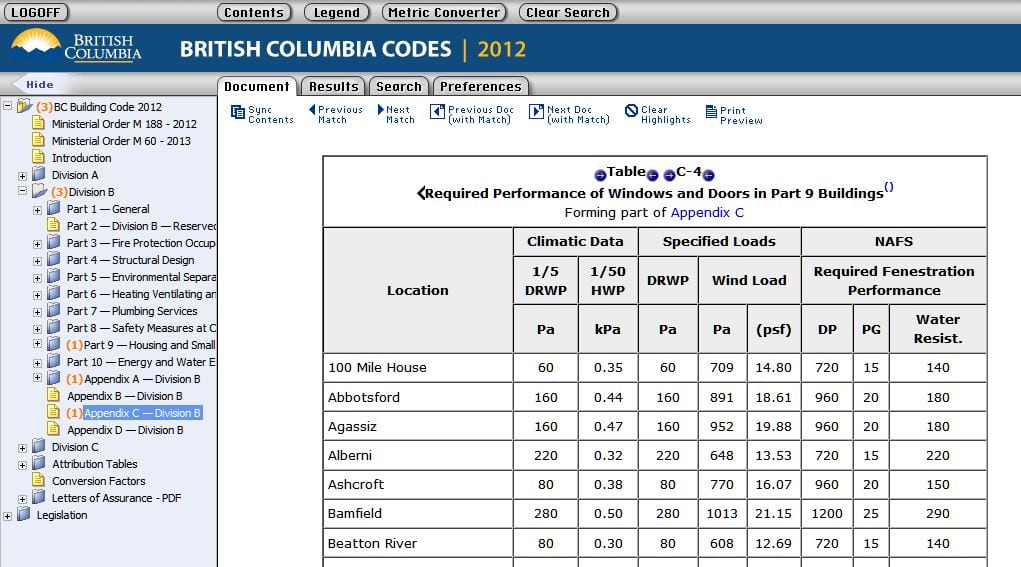In the current code cycle which began with the publication of the 2010 National Building Code, we were introduced to CSA A440S1, the Canadian Supplement to NAFS. In both Part 5 and Part 9 the code has directed us to use this standard for determining NAFS Performance Grades. Originally published in 2009, Update 1 was issued in July 2013 to harmonize climate data in Table A1 with the building code.
Over the next few years, it became apparent that the design pressure values determined for large buildings using this standard were generally higher than when calculated using Part 4 of the code, and they were significantly higher for Part 9 buildings (up to 3 storeys in height and up to 600 square meters in area). This caused significant consternation for manufacturers in British Columbia where the code minimum Performance Grade in many areas jumped as high as PG40 (design pressure of 1680 Pa or 40 psf), compared to the previous code maximum of C3 (design pressure of 1200 Pa or 25 psf), making windows and doors more expensive, and sliding windows and sliding doors no longer viable in municipalities where the new and significantly higher Canadian Supplement pressures exceeded the capability of the available products.
Discussions ensued at several levels, beginning with industry consultations by the BC Building Safety and Standards Branch in early 2015, and with a separate and independent examination of the calculation methods in CSA A440S1-09. In November 2015 the CSA A440 Technical Committee on Performance Standards for Windows studied the matter and decided to revise the calculation methods for the next edition of the standard, but it was not clear exactly when a corrected version would be published.
Without some formal recognition of the corrected calculation methods, window manufacturers and code users might not be able to use the revised calculation methods for several more years, possibly not until the next code cycle. Due to the efforts of window manufacturers, industry associations and concerned building officials, two provinces took independent action to address this matter separately from the eventual publication of a revised Canadian Supplement.
British Columbia Building Code Rev.8 (2015)
Revision 8 of the BC Building Code took effect in December of 2015, and introduced a new Table C-4 of minimum Performance Grades that apply to Part 9 buildings up to 10 m in height. These Performance Grades were determined using the same revised calculation method that was adopted by the the CSA A440 Technical Committee, and were calculated on the basis of Open Terrain to eliminate the need for users to have to make terrain determinations.
Other Part 9 buildings must continue to use CSA A440S1-09 for design wind and water pressures, while also allowing the more detailed Part 4 methods to be used for determining design wind loads.
Table C-4 is not available as a standalone document from the BC Building Safety and Standards Branch, but its contents are available from the Fenestration Canada NAFS Calculator page, as described below.

BCBC Table C4 as viewed in a web browser
CSA A440S1-17 Canadian Supplement to NAFS-11 (2017)
The corrected Performance Grade calculation methods were included in the February 2017 edition of the Canadian Supplement that was updated to harmonize with NAFS-11, and is available from the CSA store. To our knowledge, as of August 2018, this version of the standard has not been formally recognized by any Canadian jurisdiction. However it is the logical and appropriate version to use in any jurisdiction that has recognized NAFS-11, and is the version that the CSA A440 Committee recognizes as producing the more accurate Specified Wind Load and Specified Driving Rain Wind Pressure values.
Registered professionals may wish to use the 2017 edition in place of the 2009 edition as it is more closely aligned with Part 4 of the Code.
Alberta Guideline (2016-2017)
By the time the 2014 Alberta Building Code was adopted in late February of 2015, discussions were under way to correct the calculation methods in the original Canadian Supplement of 2009. Alberta Municipal Affairs was approached to learn if it would adopt a future corrected version of the Supplement when it was published, but the answer was no: there would be no updates to standards in the Alberta Building Code cycle that would run from mid-2015 to mid-2020.
This led industry participants to a creative solution: work with an engineering firm to calculate Performance Grades for all municipalities in the province, using the revised calculation methods proposed for the updated Canadian Supplement. The result was a document of tables, similar to BCBC Table C-4, supplemented with explanatory text relevant to its use in the context of the Alberta Building Code, titled “Guideline for specifying the required NAFS ratings of fenestration in low-rise buildings applicable to Part 9 of Division B of the Alberta Building Code 2014”.
This creation, publication and ultimate acceptance of this document was accomplished with the assistance of the Alberta CHBA (Canadian Home Builders Association) organization, which facilitated discussions over a period of months between window industry representatives and Alberta building officials. The aim of the Alberta CHBA was to implement NAFS with a minimum of disruption to all participants in the construction industry: builders, window and door manufacturers, and building officials.
The “Alberta Guideline” was published by the Alberta CHBA in May 2016. A year later, in May 2017, Alberta Municipal Affairs released a STANDATA variance document, 14-BCV-003R1, allowing the “Alberta Guideline” to be used in place of the 2009 Canadian Supplement to determine NAFS Performance Grades throughout the province. The Alberta Guideline can be downloaded from the here.
Fenestration Canada Online Performance Grade Calculator
The Fenestration Canada Calculator has kept up with the BC Building Code and the publication of CSA A440S1-17. Following the December 2015 Revision 8 update to the BCBC, the calculator page added a link to a PDF file of the BCBC Table C-4 Performance Grades.
At the time of this writing, it did not include any information about the Alberta Guideline document or the STANDATA that authorizes its use.
UPDATE: Since the publication of CSA A440S1-17, it has offered users the option of choosing between the 2009 and 2017 editions of the standard. Access the calculators on the Fenestration Canada website.
Which Version of the Fenestration Calculator Should You Use?
It depends on where the building is located, and on whether the Authority Having Jurisdiction (AHJ)—usually the municipal building department, but could be the architect of a building—recognizes it to be used. If the AHJ requires the use of the 2009 version of the Canadian Supplement, you will have to abide by that, or seek permission to use the newer version.
If there is no direction from the AHJ, use of the 2017 version will provide more appropriate design pressures for wind load and water penetration resistance.
Do I have to choose a Performance Grade when using the calculator?
It depends on what you want to know. If you just need the environmental loads—the wind pressure and driving rain wind pressure acting on a building—choose Performance Class R. If you are required to supply a product with a different Performance Class determined by an architect, or requested by a customer, then select the specified Performance Class. The calculator will then ensure that the minimum Performance Grade, design pressure and water test pressure are not lower than required by the specified Performance Class.




